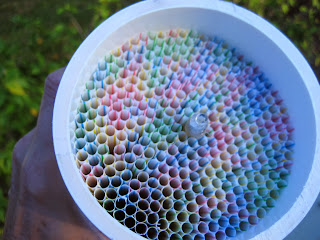Twenty-five years ago or so Peg and I took the kids to Epcot Center at Walt Disney World in Florida. While there we saw something that is a little bit difficult to describe but that I thought was way cool. Here is a clip of it from YouTube. As you can see it is still a hit with visitors. Well, I have subsequently found out that that type of fountain is called a laminar jet, and since I first saw it I've been wanting to build one. Well, I've prototyped the first phase, and here it is.
These laminar jets are kind of like the water equivalent of a laser. That is, it gets all the water flowing in the same direction so that when it flies through the air it doesn't spread out like water typically does when it comes out of a garden hose, for instance.
I pieced together how to build one from stuff on the internet, the same place I learn everything else. Below is a picture of what's inside my version. Starting at the bottom is a piece of four inch PVC pipe with a cap glued on one end and a hole drilled through the cap and into the pipe, off-center, from the side. A 3/4 inch pipe is glued into the hole. This is where the water enters the jet. To the right of that is a brass tube with an LED glued into one end and the wires for the LED coming out the other. Then comes a piece of window screen with a plastic ring to hold it in place, a two plastic scouring pads, a whole bunch of drinking straws, another scouring pad and screen with ring, and finally another cap with a hole in it.
Below is a picture of what it looks like with the LED, screen, two pads and the straws in place. You can see the LED right in the middle. I'll talk more about that LED in another post.
The way the jet works (in my admittedly simplistic understanding) is the water comes in the small pipe. When it gets into the big pipe it, of course, slows down. The screen is there to hold everything in place. The scrubbing pads break up any eddies, the straws get all the water going in one direction. The scrubbing pad at the top breaks up any eddies where the water exits the straws, the screen holds everything in place, and the water come out the hole all going in the same direction.
There is one other tricky bit, and that has to do with the hole that the water comes out. The edge of the hole should be as thin as possible so that the water contacts the edges as little as possible, thus reducing any swirling or other disturbance. The first hole I made in one of the plastic caps was perfect, and I thought this would be a piece of cake. Not so much. The next two I made had a ragged edge because the plastic tore a tiny bit. Therefore, I decided to make the holes out of brass. I turned a bunch of them on my lathe and they look good. The little hole on the side was just there to keep the brass piece from spinning in the jig as I drilled the hole, and will be covered when I glue the orifices into the plastic caps.



Genius!
ReplyDeleteWere you still considering using the washing machine valves? Or have you thought of other alternatives?
ReplyDeleteM@,
ReplyDeleteI did have an old electric washing machine valve that I tested a few years ago but it was very slow to open and close, on the order of a second or so, so there was no way it would work for this. I have another project in mind where I needed electric valves though, and the speed would not be an issue. The problem was that new washing machine valves were like 20 bucks each and I need a bunch of them for this other project. A few months back I saw some electric valves at Adafruit for less than a third of the price and so I bought a few. I tested them and they seemed to be much faster than the washing machine valve so I tried them on the laminar jet. Unfortunately they are still too slow. Instead of the tube (sausage, chunk) of water cutting off cleanly and continuing through the air it just collapses when the valve closes, destroying the effect. I guess that's why nobody uses them in this application. (Duh, look who just caught up.) I need to build what the laminar guys call a cutter, and I've been studying some designs. Watch this space.